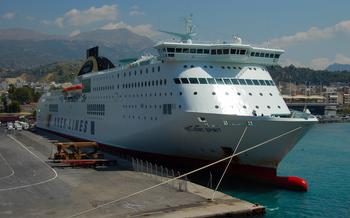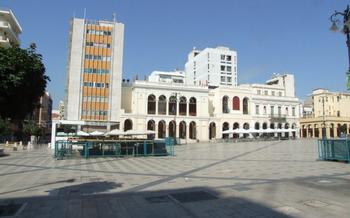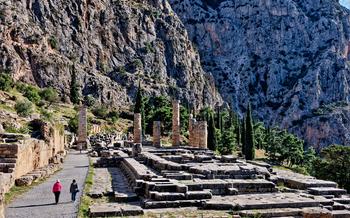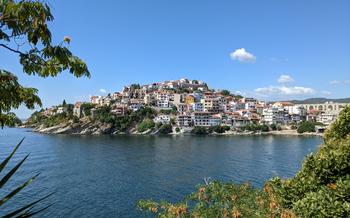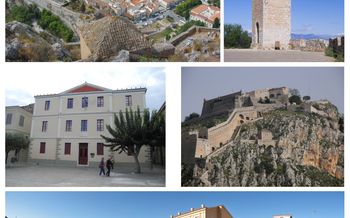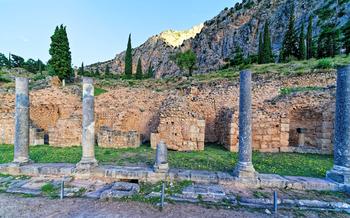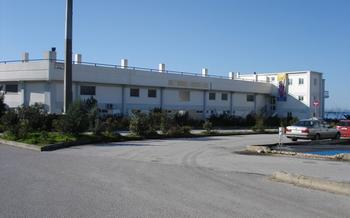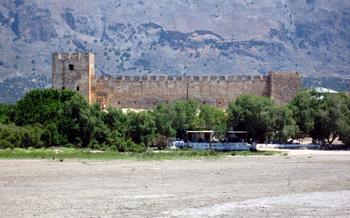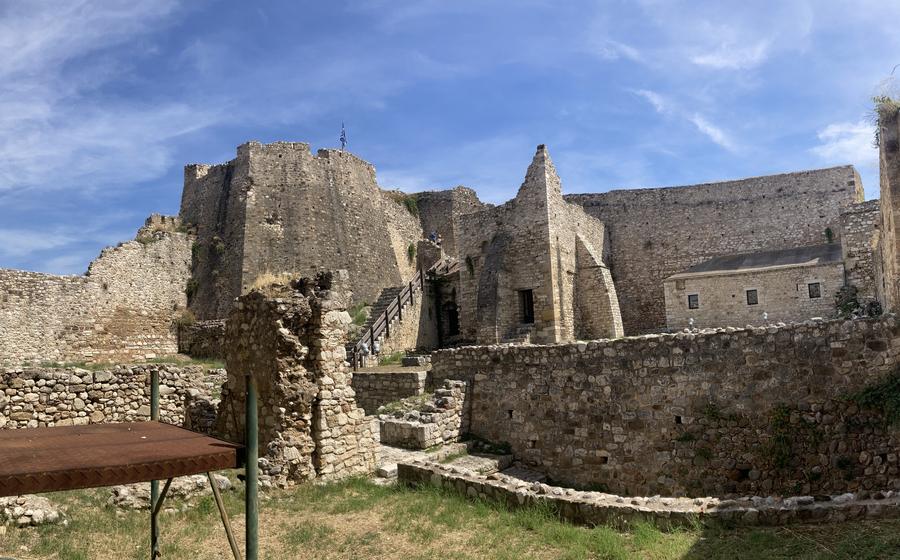
Patras Castle
- A City with Ancient Origins
- Patras Castle: A Majestic Fortress
- Exploring the Castle Grounds
- Patras Castle Museum
- The Castle's Role in Local Culture
- Byzantine and Venetian Influences
- Ottoman Occupation and Liberation
- Restoration and Preservation Efforts
- Legends and Folklore
- Guided Tours and Educational Programs
- Accessibility and Facilities
- Photography Opportunities
- Nearby Attractions
- Local Cuisine and Dining
- Insider Tip: Secret Spot
A City with Ancient Origins
Patras, a vibrant city in western Greece, boasts a rich history dating back to ancient times. According to mythology, the city was founded by Patreus, the son of Preugenes, who was a descendant of Hercules. Legends speak of the hero Hercules passing through the region and establishing a settlement that would later flourish into the city of Patras.
Archaeological findings have unearthed evidence of Patras' ancient past, including remnants of prehistoric settlements, Mycenaean tombs, and classical Greek artifacts. These discoveries attest to the city's significant role in the region's development and its enduring legacy as a cultural and historical hub.
Patras Castle: A Majestic Fortress
Patras Castle stands as a testament to the city's rich history and strategic significance. Built atop a hill overlooking the Gulf of Patras, the castle's imposing presence dominates the cityscape. Its architectural style blends Byzantine, Venetian, and Ottoman influences, reflecting the diverse cultural heritage of the region.
The castle's origins can be traced back to the 6th century AD, when Emperor Justinian I constructed a fortress to defend against Slavic invasions. Over the centuries, the castle underwent several modifications and expansions, reflecting the changing political landscape. In the 13th century, the Venetians refortified the castle, adding towers and ramparts to strengthen its defenses.
During the Ottoman occupation, the castle served as a military stronghold and administrative center. The Ottomans made significant alterations to the castle's structure, including the addition of a mosque and other Islamic architectural elements.
After Greece gained independence in 1829, the castle underwent restoration and renovation to repair the damage caused by centuries of warfare. Today, Patras Castle stands as a symbol of the city's resilience and a reminder of its rich historical past.
Exploring the Castle Grounds
The Patras Castle, with its sprawling layout, offers visitors a journey through time as they explore its various sections and notable features. The castle's outer walls, fortified with sturdy towers and imposing gates, create a sense of grandeur and security. Within the castle grounds, visitors can marvel at the well-preserved ramparts, providing panoramic views of the city and the surrounding landscape. These ramparts, with their strategic vantage points, once served as defensive structures, protecting the castle from potential invaders. As you wander through the castle's interior, you'll encounter remnants of its past, including cisterns that once supplied water to the inhabitants and secret passages that were used for covert movements during times of conflict. The Patras Castle offers an immersive experience, inviting visitors to step back in time and imagine the lives of those who once called this fortress home.
Patras Castle Museum
Within the walls of Patras Castle, a treasure trove of history and culture awaits visitors at the Patras Castle Museum. Established in 1983, the museum houses a diverse collection of artifacts that narrate the rich and storied past of the castle and the region.
The museum's exhibits span various periods, from ancient times to the present day, showcasing the diverse influences that have shaped Patras' identity. Visitors can admire ancient pottery, sculptures, and tools that provide a glimpse into the city's earliest inhabitants. Medieval artifacts, including weapons, armor, and religious objects, shed light on the Byzantine and Venetian eras.
One of the highlights of the museum is the collection of Ottoman-era artifacts, which offer insights into the period of Ottoman rule in Greece. Visitors can examine intricate ceramics, textiles, and metalwork that showcase the artistic and cultural influences of the Ottoman Empire.
The Patras Castle Museum also features a section dedicated to the Greek War of Independence, showcasing documents, weapons, and personal belongings that tell the story of the struggle for freedom against Ottoman rule.
Through its comprehensive collection and engaging displays, the Patras Castle Museum offers visitors a profound understanding of the castle's history and its significance in the cultural heritage of Greece.
The Castle's Role in Local Culture
Patras Castle stands as a symbol of pride and cultural heritage for the people of Patras and all of Greece. Over the centuries, it has played a significant role in various festivals, events, and celebrations that showcase the city's vibrant culture.
During the annual Patras Carnival, one of the largest and most colorful carnivals in Greece, the castle serves as a backdrop for lively parades, performances, and festivities. The castle's imposing walls and grand architecture create a magical atmosphere that enhances the carnival's joyous spirit.
Throughout the year, the castle hosts numerous cultural events, concerts, and exhibitions that attract both locals and visitors. These events provide a platform for local artists, musicians, and performers to showcase their talents and share their artistic expressions with the community.
One of the most unique traditions associated with the castle is the annual "Anastenaria" festival, which takes place on May 21st. This ancient pagan ritual involves fire walking and is believed to bring good fortune and protection to the city. Participants, known as "Anastenarides," dance barefoot on burning coals while carrying sacred icons, creating a mesmerizing and awe-inspiring spectacle.
The castle's presence has also played a vital role in promoting tourism and cultural heritage in Patras. Its historical significance and captivating beauty attract visitors from around the world, who come to explore its ancient ruins, learn about its rich history, and admire its architectural splendor. The castle serves as a living testament to the city's enduring legacy and cultural heritage, inspiring a sense of pride and belonging among the local community.
Byzantine and Venetian Influences
The Patras Castle, standing as a testament to the city's rich history, bears the imprints of various civilizations that have left their mark on its architecture and design. Among these, the Byzantine and Venetian influences are particularly notable, each contributing to the castle's unique character and historical significance.
Byzantine Architectural Elements:
During the Byzantine era, Patras flourished as an important center of the empire, and the castle underwent significant modifications to adapt to the changing times. Byzantine architects incorporated elements such as rounded arches, intricate stone carvings, and decorative mosaics, adding a touch of elegance and grandeur to the castle's exterior. These Byzantine influences can be seen in the castle's towers, gateways, and fortifications, blending seamlessly with the original ancient Greek architecture.
Venetian Defensive Enhancements:
When the Venetians took control of Patras in the 15th century, they recognized the strategic importance of the castle and undertook extensive renovations to strengthen its defenses. Venetian engineers reinforced the castle walls, added new towers and fortifications, and introduced innovative defensive techniques. The result was a formidable fortress capable of withstanding attacks from both land and sea.
Cultural Exchange and Historical Significance:
The Byzantine and Venetian influences on Patras Castle are not merely architectural; they also reflect the cultural exchange and historical interactions that took place during these periods. The Byzantines, with their deep-rooted Christian traditions, left their mark through religious iconography and inscriptions found within the castle walls. The Venetians, known for their maritime prowess and commercial acumen, brought their own cultural influences, contributing to the city's vibrant atmosphere and economic prosperity.
The harmonious blend of Byzantine and Venetian elements in Patras Castle showcases the complex history of the region, where different cultures intersected and influenced each other, leaving behind a rich legacy that continues to captivate visitors to this day.
Ottoman Occupation and Liberation
The Ottoman Empire left its mark on the Patras Castle during its occupation of Greece from the mid-15th century to the early 19th century. The Ottomans fortified the castle, adding new towers and ramparts to strengthen its defenses. They also constructed a mosque within the castle grounds, which served as a place of worship for the Muslim garrison.
During the Greek War of Independence (1821-1829), the castle played a crucial role as a stronghold for the Ottoman forces. The Greeks laid siege to the castle for several months, but the Ottomans held out until the end of the war. In 1829, the Ottomans finally surrendered the castle to the Greek forces, marking a significant victory in the Greek struggle for independence.
The Patras Castle stands as a testament to the resilience of the Greek people and their determination to regain their freedom. It is a symbol of Greek independence and a reminder of the sacrifices made by the Greek people during their long struggle for liberation.
Restoration and Preservation Efforts
Patras Castle, like many historical monuments, has faced the relentless passage of time and the challenges of preserving its architectural heritage. Recognizing its cultural significance, extensive restoration and preservation efforts have been undertaken to safeguard this iconic landmark for future generations.
The restoration process involved meticulous attention to detail and the application of specialized conservation techniques. Experts conducted thorough assessments of the castle's structural integrity, identifying areas in need of repair or reinforcement. Using traditional materials and methods, skilled craftsmen diligently worked to restore damaged sections, ensuring the preservation of the castle's historical character.
Preserving the castle's historical integrity was paramount throughout the restoration process. Original features, such as the distinctive stonework and intricate carvings, were carefully restored, maintaining the authenticity and charm of the structure. The use of modern conservation techniques ensured that the castle's structural stability was strengthened without compromising its historical integrity.
These restoration efforts have breathed new life into Patras Castle, allowing it to continue standing as a testament to the city's rich history and architectural heritage. By preserving this iconic landmark, the local community and visitors alike can continue to appreciate its grandeur and explore its captivating stories.
Legends and Folklore
Legends and folklore intertwine with the history of Patras Castle, adding a mystical dimension to its allure. According to local lore, the castle's foundations rest upon the bones of a giant, who was slain by Hercules, the mythical hero. Another legend speaks of a hidden treasure buried within the castle walls, guarded by a fierce dragon. The dragon, it is said, can only be appeased by a pure-hearted maiden, who must offer a sacrifice to unlock its secret.
Stories of bravery and resilience are also woven into the castle's tapestry. During the Venetian occupation, a young woman named Eleni, disguised herself as a man and fought alongside the Greek rebels. Her heroic deeds earned her the title of "Bouka Boua," or "Godmother," and she is remembered as a symbol of courage and defiance.
These legends and folk tales, passed down through generations, add a layer of enchantment to Patras Castle. They remind us of the rich cultural heritage that surrounds this ancient fortress, where history and myth converge to create a captivating narrative.
Guided Tours and Educational Programs
To enhance your visit to Patras Castle, consider joining a guided tour. These tours, led by knowledgeable experts, provide an in-depth exploration of the castle's history, architecture, and significance. Guides can share fascinating stories and anecdotes that bring the castle's past to life. They can also point out hidden details and features that you might miss on your own.
For those with a keen interest in history and culture, educational programs are offered at the castle. These programs, designed for students and visitors of all ages, provide hands-on learning experiences and interactive activities. Through workshops, lectures, and demonstrations, participants can delve deeper into the castle's history, archaeology, and cultural heritage.
These guided tours and educational programs not only enrich your visit but also contribute to the preservation and promotion of Patras Castle. By participating in these programs, you become part of the effort to safeguard this iconic landmark for future generations.
Accessibility and Facilities
Patras Castle welcomes visitors from all backgrounds and abilities, ensuring an accessible and enjoyable experience for everyone. Wheelchair ramps and designated parking spaces are available, allowing visitors with disabilities to navigate the castle grounds with ease. Restrooms are conveniently located throughout the premises, ensuring comfort and convenience for all.
To enhance the visitor experience, the castle offers a range of amenities. Refreshment kiosks and vending machines provide snacks and beverages, allowing visitors to refuel and stay hydrated during their exploration. For those looking for a more substantial meal, restaurants and cafes in the surrounding area offer a variety of culinary delights, showcasing the flavors of Patras.
Before embarking on your visit, consider planning your route to make the most of your time. The castle's layout is well-marked, with signposts and maps guiding visitors to the various sections and exhibits. Guided tours are also available, providing insights into the castle's history and significance, making it a great option for those who want to delve deeper into its stories.
Photography Opportunities
The majestic Patras Castle, with its impressive ramparts, towers, and panoramic views, presents an irresistible opportunity for photography enthusiasts. Capture the grandeur of the fortress against the backdrop of the sparkling Ionian Sea, creating a stunning contrast of colors and textures. Explore the hidden corners and quaint courtyards of the castle, discovering unique angles and perspectives that tell a story.
Photographers can indulge in macro photography, capturing the intricate details of the castle's architecture, from the weathered stones to the decorative carvings. The changing light throughout the day offers diverse opportunities for experimentation, creating dramatic silhouettes at sunrise and sunset. With every click, photographers can immortalize the timeless beauty and historical significance of this architectural masterpiece.
Tips for taking memorable photographs:
- Arrive early or stay late to capture the ethereal glow of the castle during the golden hours of dawn and dusk.
- Experiment with different angles and vantage points to create dynamic compositions.
- Explore the castle's interior spaces to capture the interplay of light and shadow, revealing the hidden stories within.
- Use a tripod to ensure sharp images, especially when shooting in low-light conditions.
- Take advantage of the natural frames created by arches, doorways, and windows to add depth and interest to your shots.
Nearby Attractions
Beyond the walls of Patras Castle, the city offers a wealth of historical and cultural attractions that beckon exploration. Discover the ancient Odeon, a well-preserved amphitheater that once hosted theatrical performances and public events. Immerse yourself in the fascinating exhibits at the Archaeological Museum of Patras, showcasing artifacts from the region's rich past. The Municipal Art Gallery houses an impressive collection of paintings, sculptures, and other artworks by renowned Greek artists. For a spiritual experience, visit the majestic Agios Andreas Church, a stunning example of Byzantine architecture and a pilgrimage site for many.
Don't miss the Patras Science Park, an interactive museum that engages visitors of all ages with hands-on exhibits and educational displays. Take a stroll along the picturesque Agiou Nikolaou Street, lined with charming cafes, shops, and historical buildings. For a taste of local life, venture into the vibrant Central Market, where vendors sell fresh produce, traditional delicacies, and handmade crafts. Whether you seek historical landmarks, artistic treasures, or modern attractions, Patras has something to offer every traveler.
Local Cuisine and Dining
Patras, like all of Greece, is a culinary paradise, and sampling the local cuisine is a must for any visitor. The city offers a diverse range of traditional Greek dishes, each bursting with flavor and showcasing the region's fresh and seasonal ingredients.
For a true taste of Patras, head to one of the many tavernas nestled near the castle. These charming establishments serve up authentic Greek dishes, prepared with love and using local produce. Indulge in mouthwatering specialties like moussaka, a hearty casserole made with layers of eggplant, potatoes, and minced meat, topped with a creamy béchamel sauce. Another must-try is pastitsio, a baked pasta dish similar to lasagna, featuring layers of pasta, minced meat, and a rich tomato sauce.
Seafood lovers will rejoice in the abundance of fresh catches available in Patras. The city's proximity to the sea means that restaurants can offer a wide variety of grilled fish, such as sea bass, red mullet, and sardines, all cooked to perfection and seasoned with simple yet flavorful ingredients.
When it comes to sweet treats, Patras is known for its delicious desserts. Baklava, a filo pastry filled with chopped nuts and sweetened with honey or syrup, is a popular choice, as is loukoumades, deep-fried dough balls drizzled with honey and sprinkled with cinnamon.
To fully immerse yourself in the local culinary experience, consider participating in a cooking class. Learn the secrets of Greek cuisine from experienced chefs and recreate traditional dishes in a fun and hands-on environment.
As you savor the delectable flavors of Patras, remember to embrace the city's vibrant food culture. Whether you're enjoying a leisurely meal at a traditional taverna or sampling street food from local vendors, each bite is a testament to the rich culinary heritage of this captivating city.
Insider Tip: Secret Spot
As you explore the castle grounds, keep an eye out for a hidden gem—a secluded spot that offers a tranquil escape from the bustling crowds. Nestled amidst the ancient walls, this secret spot invites visitors to immerse themselves in the castle's rich history and serene ambiance.
Whether you seek a moment of solitude or a place to unwind after a day of exploration, this hidden haven provides a sanctuary for reflection and contemplation. As you sit in tranquility, let the castle's stories whisper in your ears, transporting you back in time to witness the triumphs and struggles that unfolded within these walls.
Discover the secret spot, embrace its tranquility, and create a memory that will linger long after your visit to Patras Castle.
